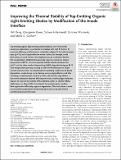Files in this item
Improving the thermal stability of top-emitting organic light-emitting diodes by modification of the anode interface
Item metadata
| dc.contributor.author | Deng, Yali | |
| dc.contributor.author | Keum, Changmin | |
| dc.contributor.author | Hillebrandt, Sabina | |
| dc.contributor.author | Murawski, Caroline | |
| dc.contributor.author | Gather, Malte C. | |
| dc.date.accessioned | 2020-11-20T17:30:02Z | |
| dc.date.available | 2020-11-20T17:30:02Z | |
| dc.date.issued | 2020-11-20 | |
| dc.identifier | 270942807 | |
| dc.identifier | a824a40b-43de-4de5-b564-4fcef5a9bcc8 | |
| dc.identifier | 85096656391 | |
| dc.identifier | 000590608900001 | |
| dc.identifier.citation | Deng , Y , Keum , C , Hillebrandt , S , Murawski , C & Gather , M C 2020 , ' Improving the thermal stability of top-emitting organic light-emitting diodes by modification of the anode interface ' , Advanced Optical Materials , vol. Early View , 2001642 . https://doi.org/10.1002/adom.202001642 | en |
| dc.identifier.issn | 2195-1071 | |
| dc.identifier.other | ORCID: /0000-0002-4857-5562/work/83889575 | |
| dc.identifier.uri | https://hdl.handle.net/10023/21025 | |
| dc.description | This research was financially supported by the EPSRC NSF-CBET lead agency agreement (EP/R010595/1, 1706207), the DARPA-NESD program (N66001-17-C-4012) and the Leverhulme Trust (RPG-2017-231). Y.D. acknowledges a stipend from the Chinese Scholarship Council (CSC). C.K. acknowledges support from the Basic Science Research Program through the National Research Foundation of Korea (NRF) funded by the Ministry of Education (2017R1A6A3A03012331). M.C.G. acknowledges support from the Alexander von Humboldt Stiftung through the Humboldt-Professorship. | en |
| dc.description.abstract | Top‐emitting organic light‐emitting diodes (OLEDs) are of interest for numerous applications, in particular for displays with high fill factors. To maximize efficiency and luminance, molecular p‐doping of the hole transport layer (p‐HTL) and a highly reflective anode contact, for example, made from silver, are used. Atomic layer deposition (ALD) is attractive for thin film encapsulation of OLEDs but generally requires a minimum process temperature of 80 °C. Here it is reported that the interface between the p‐HTL and the silver anode of top‐emitting OLEDs degrades during an 80 °C ALD encapsulation process, causing an over fourfold reduction in OLED current and luminance. To understand the underlying mechanism of device degradation, single charge carrier devices are investigated before and after annealing. A spectroscopic study of p‐HTLs indicates that degradation is due to the interaction between diffusing silver ions and the p‐type molecular dopant. To improve the stability of the interface, either an ultrathin MoO3 buffer layer or a bilayer HTL is inserted at the anode/organic interface. Both approaches effectively suppress degradation. This work shows a route to successful encapsulation of top‐emitting OLEDs using ALD without sacrificing device performance. | |
| dc.format.extent | 8 | |
| dc.format.extent | 1756592 | |
| dc.language.iso | eng | |
| dc.relation.ispartof | Advanced Optical Materials | en |
| dc.subject | Atomic layer deposition encapsulation | en |
| dc.subject | Buffer layer | en |
| dc.subject | Device degradation | en |
| dc.subject | Silver diffusion | en |
| dc.subject | Thermal stability | en |
| dc.subject | Top-emitting organic light-emitting diodes | en |
| dc.subject | QC Physics | en |
| dc.subject | TK Electrical engineering. Electronics Nuclear engineering | en |
| dc.subject | DAS | en |
| dc.subject.lcc | QC | en |
| dc.subject.lcc | TK | en |
| dc.title | Improving the thermal stability of top-emitting organic light-emitting diodes by modification of the anode interface | en |
| dc.type | Journal article | en |
| dc.contributor.sponsor | US Department of Defence | en |
| dc.contributor.institution | University of St Andrews. School of Physics and Astronomy | en |
| dc.contributor.institution | University of St Andrews. Sir James Mackenzie Institute for Early Diagnosis | en |
| dc.contributor.institution | University of St Andrews. Centre for Biophotonics | en |
| dc.contributor.institution | University of St Andrews. Biomedical Sciences Research Complex | en |
| dc.identifier.doi | 10.1002/adom.202001642 | |
| dc.description.status | Peer reviewed | en |
| dc.identifier.grantnumber | N66001-17-C-4012 | en |
This item appears in the following Collection(s)
Items in the St Andrews Research Repository are protected by copyright, with all rights reserved, unless otherwise indicated.

